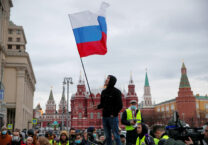Over four days this week, the Israeli military killed two journalists and severely injured at least three others. The attacks are part of the harrowing toll taken on Gaza’s press corp since the military began its all-out assault on the Palestinian territory just over a year ago.
On Wednesday, as Israel intensified its attacks on the northern Gaza Strip, the military attacked the Jabaliya refugee camp, killing Mohamed al-Tanani, a cameraman for Al-Aqsa TV, and injured his colleague Tamer Labad. Fadi al-Hawidi, a cameraman for Al Jazeera Arabic, was shot in the neck and, according to other journalists in Gaza, is now permanently paralyzed due to his injuries.
According to the government media office in Gaza, 175 journalists have been killed since October 7, not including al-Tanani.The assault on Jabaliya came as the Israeli military laid a siege that saw attacks on hospitals, homes, and other civilian areas. The entire northern region of Gaza was put under evacuation orders by the Israelis, with the military directing civilians to flee to areas already overcrowded in the south.
The journalists were covering the siege and the ill-fated attempts by civilians to flee on Wednesday when they were attacked. Witnesses said the journalists were targeted. Like other Palestinian journalists who have been killed and injured in Gaza, al-Hawidi was wearing a flak jacket with the word “PRESS” clearly visible on it.
“It was not random, but direct targeting on purpose,” journalist Hossam Shabat, who had been with al-Hawidi and other reporters in Jabaliya on Wednesday, told The Intercept. “Fadi was wearing his press uniform which distinguishes him from the residents as a journalist.”
The casualties among journalists punctuated the latest chapter in a war that has, week after week, been as brutal as it has been tragic for Palestinians in Gaza.
The toll has been especially heavy for journalists. According to the government media office in Gaza, 175 journalists have been killed since October 7, not including al-Tanani. The Committee to Protect Journalists, which has tallied 126 journalist killings carried out by Israeli forces, says that the toll is the highest it has documented in a single year since the group began recording killings in 1992.
As of late June, nine months into the war, an analysis from Arab Reporters for Investigative Journalism and The Intercept, collaborating as part of the Gaza Project on the destruction of press infrastructure in the strip, found that 1 in 10 journalists in Gaza had been killed by the Israeli military.
Covering Attacks on Civilians
In his last post on Instagram before he was shot in the neck, al-Hawidi, the Al Jazeera Arabic journalist, filmed himself as he reported on civilians being shot at by Israeli forces while attempting to leave the area in compliance with the military’s orders. Unarmed people can be seen running as gunfire rings in the background.
The reporters who came under fire were not near military vehicles, said Shabat, a journalist who reports for Al Jazeera Mubasher.
Speaking on Al Jazeera, correspondent Anas al-Sharif echoed Shabat’s account, saying that he, al-Hawidi, and the other journalists began to move after the gunfire.
“Suddenly a quadcopter drone appeared above the broadcast vehicle and the place where we were, and it started firing directly at us,” al-Sharif said. “The drone started chasing us and the entire crew, firing directly at us. A bullet hit my colleague Fadi’s neck and he immediately passed out and fell to the ground.”
In footage broadcast by Al Jazeera, al-Hawidi can be seen lying face down on the sidewalk, not moving. His colleagues can be heard off camera, desperately calling his name over and over. (The Israeli military did not immediately respond to a request for comment.)
 Medics and colleagues of Al Jazeera photojournalist Fadi al-Wahidi, who was shot in the neck by Israeli troops while reporting in the northern Gaza Strip, at Al-Ahli Arab hospital in Gaza City on Oct. 9, 2024.
Photo: Omar al-Qatta/AFP via Getty Images
Medics and colleagues of Al Jazeera photojournalist Fadi al-Wahidi, who was shot in the neck by Israeli troops while reporting in the northern Gaza Strip, at Al-Ahli Arab hospital in Gaza City on Oct. 9, 2024.
Photo: Omar al-Qatta/AFP via Getty Images
Al-Aqsa journalists Mohamed al-Tanani and Tamer Labad had also been covering the Israeli incursion on Jabaliya when they were attacked, according to Ibrahim al-Khalili, a reporter working with Al Jazeera English. In footage taken by another journalist, Mahmoud Abusalama of Alghad TV, paramedics with the Palestine Red Crescent Society said that they were attacked four times while trying to reach al-Tanani and Labad.
“We received his” — al-Tanani’s — “body in Al-Ahli hospital in northern Gaza,” al-Khalili told The Intercept. “We bid the last farewell to him and then we went to bury him.”
Footage taken by al-Khalili shows Altanani body’s being prepared for burial still wearing his press flak jacket.
Recalling his friend and colleague, al-Khalili said al-Tanani was a dedicated and tireless journalist.
“He worked since day one to cover the atrocities and bombardments and ground incursions taking place in northern Gaza City,” al-Khalili said. “He always gave advice to me. We miss him, we miss him so much. We are heartbroken.”
“We as journalists here feel like we are the target of the occupation while just showing what’s happening on the ground and showing the truth to the world.”
“He Continued Reporting”
The first deadly attack on journalists this week took place on Sunday when Hassan Hamad was killed in an Israeli airstrike on his home in Jabaliya. According to colleagues, Hamad had said that he had received threats telling him to stop reporting in Gaza.
On Monday, another Al Jazeera journalist, Ali al-Attar, was injured in an attack near the Al-Aqsa hospital in Deir al-Balah, in the central Gaza Strip. Al-Attar was wounded by two pieces of shrapnel that hit his head and is in critical condition.
Al Jazeera and the Committee to Protect Journalists have said that he urgently needs to be evacuated for medical treatment due to the attacks on Gaza’s hospitals that have left the health care system decimated. His colleagues in Gaza have echoed the plea, worrying that a failure to evacuate al-Attar would doom his recovery.
Journalists with Al Jazeera, a Qatar-based Arabic language network, have been repeatedly attacked by the Israeli military over the past year, with four killed. (I was previously a producer for “Fault Lines,” a documentary series on Al Jazeera English.) In September, the Israeli military raided and shuttered Al Jazeera’s office in the occupied West Bank.
The footage of al-Hawidi lying unconscious on the sidewalk after being shot was eerily reminiscent of video documenting the deliberate killing of Shireen Abu Akleh, Al Jazeera’s longtime correspondent in the occupied West Bank.
Abu Akleh, a Palestinian American, was shot in the head by an Israeli sniper in May 2022 while covering a military raid on the Jenin refugee camp and wearing a clearly marked press vest. Days after a May 2023 report by the Committee to Protect Journalists excoriated the Israeli military for a lack of accountability in her death, it apologized for the incident, though without imposing any consequences for the killing. A U.S. investigation into the shooting has not been concluded.
Since the war began last year, Israel has prohibited foreign journalists from entering Gaza unless they embed with the military. It’s made the work of Palestinian journalists more crucial as they document the war and devastating toll on civilians — even as Palestinian journalists working for Western news outlets have faced direct attacks.
Shabat told The Intercept he believes Al Jazeera’s journalists in Gaza are being targeted, including al-Wahidi.
“The occupation army targets journalists and targeted Fadi because he was reporting the opposite of what the occupation army says.”“The occupation army targets journalists and targeted Fadi because he was reporting the opposite of what the occupation army says, which is that the camp” — Jabaliya — “is empty and it’s only targeting militants,” Shabat said. “Fadi reported that those targeted are children.”
“Fadi as a journalist was very proactive and very, very hardworking,” he said. “When the rescue workers would remove body parts and the injured, I would see tears in Fadi’s eyes because he is a journalist and a human being.”
Like too many of Gaza’s press corps, al-Wahidi has suffered the same atrocities he labored to document. With his paralysis and the decimation of Gaza’s health care system, his future as a journalist is uncertain.
Shabat said, “Fadi lost so many friends and relatives, but he continued reporting.”
The post Witnesses: Israeli Attacks Directly Targeted Journalists In Northern Gaza appeared first on The Intercept.

 1 month ago
33
1 month ago
33



